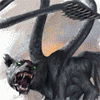|
Covok posted:How does FASERIP stack up to modern offerings in the superhero genre? I'm afraid I can't answer that as I have little experience with either - I just thought it would be worth telling the thread it was complete as it mentioned that it was being made earlier. As much as I can see, FASERIP character creation is randomly determining your powers, removing any that don't make sense with a theme you've chosen in order to exchange them for other background things - wealth, skills, etc. Modern Superhero games pretty much allow you to choose everything, to allow you to create the superhero of your childhood dreams, but such systems are easily broken so there's an unspoken agreement to knock break the rules over your knee. LashLightning fucked around with this message at 20:51 on Apr 23, 2015 |
|
|
|

|
| # ? May 22, 2024 11:19 |
|
obeyasia posted:The box set is very content rich. You could easily get 4-5 entire adventures out of it, even starting with a level 0 funnel. The amount of background info on the people, monsters, artifacts/items, and lore is amazing. Well worth the price of admission. Agreed. The player handouts and the DM screen are also really cool. I've been getting a lot of mileage out of The Chained Coffin box set with my group and I can't wait to have them stumble through a portal to the Purple Planet next.
|
|
|
|
I did a quick breakdown of an OD&D retroclone I recently discovered: Iron Falcon, by Chris Gonnerman, who also did Basic Fantasy RPG. While I take some issue with increased bonuses from attribute scores that were not present in the original, the book is otherwise a very faithful and tightly written restatement of OD&D, without doing things like Swords and Wizardry's collapsing all the saving throws into 1 number.
|
|
|
|
obeyasia posted:The box set is very content rich. You could easily get 4-5 entire adventures out of it, even starting with a level 0 funnel. The amount of background info on the people, monsters, artifacts/items, and lore is amazing. Well worth the price of admission. I heard that it was very hexcrawl heavy. I trust there are some dungeons packed in there? gradenko_2000 posted:I did a quick breakdown of an OD&D retroclone I recently discovered: Iron Falcon, by Chris Gonnerman, who also did Basic Fantasy RPG. While I take some issue with increased bonuses from attribute scores that were not present in the original, the book is otherwise a very faithful and tightly written restatement of OD&D, without doing things like Swords and Wizardry's collapsing all the saving throws into 1 number. Hey, if S&W hadn't done that I might never have realized that OD&D only had 2 save progressions. Wizard vs wand, and everything else. So, why is it called Iron Falcon? Unrelated, I recently read this post concerning a GMing strategy that I happened to already be using: http://goblinpunch.blogspot.com/2015/04/just-in-time-compilation.html I think it works quite well with rules light play like Into the Odd. Well, actually I think it's the right way to handle these sorts of rolls in general.
|
|
|
|
DalaranJ posted:So, why is it called Iron Falcon? After reading through the development notes, it's a play off of Greyhawk. Apparently it's a clone of OD&D + Greyhawk, because (according to the author) the Greyhawk supplement was the first time that D&D split off enough from its Chainmail/wargaming roots to become a fully playable game all by itself and become recognizably D&D. EDIT: Looking at the original Greyhawk supplement, apparently that one did have the +1 to +3 attribute bonuses, so yes it would seem like Iron Falcon really is a purist retroclone for what it's emulating. gradenko_2000 fucked around with this message at 06:57 on Apr 24, 2015 |
|
|
|
DalaranJ posted:I heard that it was very hexcrawl heavy. I trust there are some dungeons packed in there? There are 7-8 dungeons of various sizes in addition to all the sandbox/hexcrawl stuff. The box really is stuffed.
|
|
|
|
Man Dancer posted:There are 7-8 dungeons of various sizes in addition to all the sandbox/hexcrawl stuff. The box really is stuffed. That is pretty impressive. So, here are some ideas I've been batting around for Into the Odd exploration. I don't know that I'd bother using them in a one-shot, but after running a couple times I've been considering doing a campaign. Difficult Saves- Subtract 4 from your ability score before rolling a 'Hard' save Supplies- You can purchase supplies for 1.5 s each. Each supply takes up the space of one item (see encumbrance below). A supply represents any number of a variety of exploration resources and can be spent to provide any of those resources: Enough preserved food for 3 meals. Enough water, brandy, and bandages for an entire party to take a short rest. A spare torch or lantern. One of the items listed under tools. A pack mule can carry 20 'supplies'. A cart or a larger pack animal (like my elephant) can carry 50 'supplies'. At this point stop counting until the party separates from their source of supply. Encumbrance- 0-3 items carried, not encumbered 4-6 items carried, encumbered: You move somewhat more slowly than other people (but not enough to affect travel time), when you make a Dexterity save it is always 'Hard'. Some large (treasure) items may count as more than one item. (Armor counts as 1 item.) Light- You are well lit if you are carrying or adjacent to the person carrying a light source. You are dimly lit if you are in the same room as someone carrying a light source. Being in dim light makes it impossible to read, and may make tasks involving manual dexterity difficult. So how do these look? I tried to address major exploration ideas while remaining as light as possible.
|
|
|
DalaranJ posted:That is pretty impressive. They seem pretty solid to me. How are you going to be handling the use of resources in your game? I had wanted to go more detailed in regards to exploration in my own ItO hack at first, but decided to go more into combat instead and didn't want to expand both aspects at the same time. I stole the Advantage/Disadvantage thing from D&D for my own difficult checks - I think when someone had crunched the numbers it worked out to about a 4.5 point bonus/penalty on average. I like the abstract way you are tracking encumbrance by number of items rather than any kind of weight system. I did the same thing in mine (2 weapons, armor and 10 other items that don't fit those categories). How are you going to track things like torches burning out? Time tracking has always seemed to be kind of the big issue in exploration heavy games.
|
|
|
|
|
Time tracking is actually really really easy if you have paper plates, a marker, and a brad.
|
|
|
Babylon Astronaut posted:Time tracking is actually really really easy if you have paper plates, a marker, and a brad. All this time and apparently the answer had been in that one activity we did in Kindergarten to learn how clocks work. Seriously, how had I never considered that?
|
|
|
|
|
There's even been the occasional sold product to that effect.  But making your own should be stupidly easy and quick. But making your own should be stupidly easy and quick.
|
|
|
|
Bob Quixote posted:They seem pretty solid to me. How are you going to be handling the use of resources in your game? I had wanted to go more detailed in regards to exploration in my own ItO hack at first, but decided to go more into combat instead and didn't want to expand both aspects at the same time. Supplies are intended to represent an amalgamation of all generic (adventuring) resources. Items that would be more granular than a single supply (such as bullets and gunpowder) are incidental as long as supply is available. I was considering a rule for not always being able to produce free items if your supplies are low, but I don't know if that would actually be enjoyable or tedious. I haven't put a lot of thought into handling more specific resources. I might come up with a wear and tear rule, so that you eventually have to replace weapons and armor? Bob Quixote posted:I stole the Advantage/Disadvantage thing from D&D for my own difficult checks - I think when someone had crunched the numbers it worked out to about a 4.5 point bonus/penalty on average. My preference for difficult checks would be to penalize more skilled people more than unskilled people if possible. Both a flat subtraction method and Advantage are sort of equally bad at that though. Bob Quixote posted:I like the abstract way you are tracking encumbrance by number of items rather than any kind of weight system. I did the same thing in mine (2 weapons, armor and 10 other items that don't fit those categories). I have no idea what an appropriate encumbrance limit is yet. I kept it at six hoping that that would be a value that was inside players automatic memory range. I forgot a very important encumbrance rule though. Here it is: Arcana don't react well to being kept in close proximity. At the beginning of any day in which you are carrying more than one Arcana on your person roll on the following table (that I haven't completed yet). 1-3: Things get one step worse, if they are already as bad as they can get (i.e. a 4) all the arcanum you are carrying are destroyed and you take d12 damage per arcana destroyed this way. 5: The arcana are producing some sort of resonance together that greatly dulls one of your senses, either sight, sound or touch Bob Quixote posted:How are you going to track things like torches burning out? Time tracking has always seemed to be kind of the big issue in exploration heavy games. Lantern oil and replacement torches are incidentals. You only have to pay supply to bring an additional light source into play. Of course, that doesn't mean that time tracking is unneeded. You could leave a light source somewhere and it would eventually burn out, and there are plenty of other reasons to have a time system (that I can't some up with right now). I think I would make one clock 'tick' every time I rolled for a random encounter (discounting 'bonus' noise/environment caused rolls , of course).
|
|
|
|
A Strange Aeon posted:I found these really cool 2nd Edition Random Encounter decks that I didn't even know existed at a game store in Michigan when I was visiting my in-laws over the holidays. They're an official TSR product from the early 90s, and each set has hundreds of these index cards with encounters on them. I own that somewhere in my box of abandoned stuff. Need to dig it out.
|
|
|
|
Besides the recent Dungeon Crawl Classics PbP, is there/has there been an SA PbP of pre-3rd Ed D&D or an OSR retroclone I could read through?
|
|
|
|
I was reading through the original Chainmail rules today and found that owing to spellcasters in that game acting as fantasy field artillery, it did not use Vancian casting at all. Instead, spells were given a complexity rating: casting Darkness over the playing field is a complexity 1 spell, while casting Slowness is a complexity 3 spell, Cloudkill is a complexity 5 spell, and Anti-Magic Shell caps out at complexity 6. When casting a spell, the player makes a 2d6 roll, and the result compared to the spellcaster's level and the spell's complexity will determine if the spell is cast immediately, or is delayed by 1 turn, or fails to take effect entirely. The weakest spellcaster, a Seer, needs to roll an 8 or better on a 2d6 to immediately cast a complexity 1 spell. Rolling a 7 will delay the spell by 1 turn, and anything less will cause the spell to not take effect at all. A complexity 3 spell would need a roll of 10 on a 2d6 for immediate casting, or a 9 for a 1 turn delay, and any lower causes no effect. A Seer would never be able to immediately cast a complexity 6 spell, and would need a 12 just to be able to cast it with a 1 turn delay. A Wizard, the highest level spellcaster, can reliably cast spells of up to complexity 4 (7 needed for immediate effect). The other thing I noticed with regards to the spellcasting system is that many spells have no listed duration. Instead, a spellcaster is limited by the number of spells they are able to "manage" at any one time. The lowly Seer can only maintain one spell, which may well be the complexity 1 Darkness, while a Wizard can keep 6-7 spells going at the same time. Finally, with the exception of Cloudkill, the spell list does not contain direct damage spells. Spellcasters could use Fireball and Lightning Bolt, but these could be called upon "at-will" and didn't pass through the whole spellcasting system.
|
|
|
gradenko_2000 posted:I was reading through the original Chainmail rules today and found that owing to spellcasters in that game acting as fantasy field artillery, it did not use Vancian casting at all. That sounds pretty interesting - you can really see the wargamey roots there with the whole "roll 2d6 and consult a chart" spellcasting method, but the mechanics for managing ongoing spells, delayed casting, spell complexity, etc. all seem like something that could be imported relatively easily into a retroclone. At-will Fireball/Lightning bolt might be a bit OP if you aren't routinely fighting armies like the rules were devised for though.
|
|
|
|
|
gradenko_2000 posted:I was reading through the original Chainmail rules today and found that owing to spellcasters in that game acting as fantasy field artillery, it did not use Vancian casting at all. That's super interesting. I'm surprised I didn't know about that already, it seems ripe for a Grognardia post, but I don't remember one about it. Like the person above me said, that mechanic is prefect to be implemented in a retro clone. I like how you could try to cast anything, but your success rate is low for the stuff way above your level. Also I like the delayed partial success; seems ahead of its time and more consequential than a half damage result or something. And it doesn't get into DCC level idiosyncratic tables for each spell.
|
|
|
|
I just came across a pile of old TSR books and adventures. Are there any people would recommend as particularly good reads or inspirations for play?
|
|
|
|
Anything Dark Sun and Planescape is good, I quite like Infinite Staircase, Modron March and Dead Gods from the latter. Dark Sun is a big sandbox, just read the setting. Do you have any of the Dragon Magazine stuff?
|
|
|
|
Moriatti posted:Dark Sun is a big sandbox
|
|
|
|
Zurui posted:I just came across a pile of old TSR books and adventures. Are there any people would recommend as particularly good reads or inspirations for play?
|
|
|
|
Can someone explain to me non-weapon proficiencies in AD&D 2e? I've tried reading the section a couple of times and I just can't grok it.
|
|
|
|
gradenko_2000 posted:Can someone explain to me non-weapon proficiencies in AD&D 2e? I've tried reading the section a couple of times and I just can't grok it. Some of them are more fleshed out than others obviously, and some of them have synergies (healing + herbalism lets you heal a small amount of damage using poultices or whatever, this is a normal standby for a group that doesnt want/have a cleric). Some of them sound silly (rope use) but the assumption (with us) is that this is not "tie a knot" its proper rigging/lasso/whatever. Generally we assumed that a basic version of whatever it is is automatically successful/good, and checks were for Serious Things. (So someone with Cooking can always cook good food, but if you want to do some kind of scam/gambit to match the dishes at a fancy place and conceal your poison thats a check.) There were also the "backgrounds/professions" that were optional, the rough idea was that was your "family business" or previous career, and essentially something that the character knew the ins and outs of well enough to set up shop (so to speak) if it was ever needed/interesting. This is all from memory though. Any specific things?
|
|
|
|
Okay, so if I'm understanding this correctly, "skill checks" in AD&D 2e are similar to B/X: roll a d20 and get equal to or lower than the associated attribute to succeed, and then a Non-Weapon Proficiency acts as a modifier on the roll. And also with the general DM advice of only calling for a roll if the situation is difficult, desperate or otherwise uncertain. If Bob McFighter has the Reading Lips NWP, then he needs to quickly discern what the Goblin Warlord is talking about from a distance, he rolls a d20 and needs to get equal to or lower than his INT-2 to succeed. He can spend further NWP slots on Reading Lips to improve it to INT-1 or even INT+1, making the rolls easier to succeed at. Warriors start with 3 NWPs and gain 1 more every 3 levels Wizards and Priests start with 4 NWPs and gain 1 more every 3 levels Rogues start with 3 NWPs and gain 1 more every 4 levels The number of languages granted by your INT attribute also defines how many more NWPs you start with.
|
|
|
|
Yes, that is correct - I believe the bonus NWP slots thing may have been optional though. You could (either optionally or in place of) NWPs roll for Secondary Skill, which can give certain skillsets that the normal nonweapon stuff didn't cover (there was some overlap).
|
|
|
|
gradenko_2000 posted:Okay, so if I'm understanding this correctly, "skill checks" in AD&D 2e are similar to B/X: roll a d20 and get equal to or lower than the associated attribute to succeed, and then a Non-Weapon Proficiency acts as a modifier on the roll. And also with the general DM advice of only calling for a roll if the situation is difficult, desperate or otherwise uncertain. This is by and large correct. The DM can declare that you can't attempt some NWP-related rolls at all without spending a point (things like gem cutting), a few which have "limited game use" have suggestions to not be rolled if you have them or you're under duress (carpentry - just get the slot and you're a carpenter and don't need to roll if you're doing basic carpentry but might roll for unusual jobs) and a few are more like the Feats we're familiar with from later material like Blind-Fighting. And some NWPs are more difficult to learn and need more empty slots to get at all. Really, it's a simple system with cruft on top.
|
|
|
|
gradenko_2000 posted:The number of languages granted by your INT attribute also defines how many more NWPs you start with. We were pretty generous with things that fit the background and had the fringe benefit of reminding people to branch out w narrative. The minor noble offspring might get etiquette and heraldry for free. The sheltered priest might get religion and some history, etc... This let people have some fluffy ones for our nerdy story games without losing out on Alertness, Tumbling, Spellcraft, Blind Fighting, and the other more crunchy ones. Whether this matters or not depends on the DM for the most part. We liked the (extremely) nerdy history/natural science/ecology stuff that some people explicitly dislike. If the DM hates the idea of astrology forecasts/heraldry/ancient history they should probably make that known ahead of time so no one wastes a spot on them. We also unofficially treated specialized NWPs like weapon specializations. So regardless of the stat check if you had NWP(x2) you were among the best in your geographic area. If you had NWP(x3) you were a known (or unknown?) master at it... etc. Having a couple of people with Healing/Herbalism frees up the group a lot from the mandatory healer thing. A Healing check "stabilizes" someone bleeding (-1 hp to -10hp) directly to Unconscious (0 hp). The combo check (or used of prepared materials/medicines/whatever) healed (uh.. 1d3?) from a freshly wounded person. If you track time vs healing being under the care of someone with those skills also increased the daily recovery rate. This doesnt mean much at level 10, but makes level 1-5 a lot better/less lethal, while still keeping the aspiring/desperate vibe. There was one version of the Running+Endurance combo that was hilarious if you converted to real world measurements too. I had my barbarian chase down a Caribou on foot and snap its neck to get his favorite harpoon back in a not-too-serious game. 2e: when fighters were dangerous and mages were fragile.
|
|
|
|
I've been reading Ovid's Metamorphoses and it has some interesting stuff in it. I'm sure most of you are familiar with Greek myths, but some of the language this translator uses is just really inspiring. Anyway, what I thought might interest everyone is this passage: ...and Minos contrived to hide this specimen in a maze, a labyrinth built by Daedalus, an artist famous in building, who could set in stone confusion and conflict, and deceive the eye with devious aisles and passages. As Maeander plays in the Phrygian fields, a doubtful river, flowing and looping back and sends its waters either to source or sea, so Daedalus made those innumerable windings wander, and hardly found his own way out again, through the deceptive twistings of that prison. It basically describes a dungeon, which I thought was cool. And speaking of dungeons, I've been re-reading the RC because I'm going to transition my group's DCC funnel characters into RC once they get to first level, and there's a really strange idea about what wizards do when they get their own tower at level 9. They're apparently known for building dungeons underneath their tower, and leaving at least one unguarded entrance, to attract monsters to live there. Like, this is a known thing wizards do, and sometimes the people in the region get upset because the neighborhood wizard is basically inviting monsters into the area, who I guess are just naturally attracted to dungeons. It's such a funny idea to be a foundation of a setting, but it's also very flavorful and goes some way to explaining the concept of why dungeons are a thing. The demihuman relics are also a really unique, kind of weird touch in RC. And how the spells work slightly differently than I remember--like, how Cure Light Wounds can also cure paralysis, but if you use it that way, it doesn't heal any HP. And how Protection from Evil prevents enchanted creatures from touching you. I never played Basic or Expert, so maybe those were standard, but coming from 2E, some of the details are quite interesting.
|
|
|
|
FRINGE posted:We also unofficially treated specialized NWPs like weapon specializations. So regardless of the stat check if you had NWP(x2) you were among the best in your geographic area. If you had NWP(x3) you were a known (or unknown?) master at it... etc. We did sorta the same thing in 2e. I'm pretty sure "take the NWP more than once for a bonus" is an optional rule from somewhere. I'm sure I've seen it written down in a rulebook, anyway. I couldn't possibly tell you where and I'm in the middle of reshuffling the house so most of my RPG stuff is boxed away.
|
|
|
|
AlphaDog posted:We did sorta the same thing in 2e. I'm pretty sure "take the NWP more than once for a bonus" is an optional rule from somewhere. I'm sure I've seen it written down in a rulebook, anyway. I couldn't possibly tell you where and I'm in the middle of reshuffling the house so most of my RPG stuff is boxed away. The PHB says it flat out, that you can take an NWP more than once to gain a greater bonus. Anyway, thanks for the answers, all. I get it now. A Strange Aeon posted:And speaking of dungeons, I've been re-reading the RC because I'm going to transition my group's DCC funnel characters into RC once they get to first level, and there's a really strange idea about what wizards do when they get their own tower at level 9. They're apparently known for building dungeons underneath their tower, and leaving at least one unguarded entrance, to attract monsters to live there. Like, this is a known thing wizards do, and sometimes the people in the region get upset because the neighborhood wizard is basically inviting monsters into the area, who I guess are just naturally attracted to dungeons. It's such a funny idea to be a foundation of a setting, but it's also very flavorful and goes some way to explaining the concept of why dungeons are a thing. The idea that dungeons are a semi-sentient thing that justifies its own existence is one of the cooler concepts I've been introduced to by the hobby.
|
|
|
|
A Strange Aeon posted:And speaking of dungeons, I've been re-reading the RC because I'm going to transition my group's DCC funnel characters into RC once they get to first level, and there's a really strange idea about what wizards do when they get their own tower at level 9. They're apparently known for building dungeons underneath their tower, and leaving at least one unguarded entrance, to attract monsters to live there. Like, this is a known thing wizards do, and sometimes the people in the region get upset because the neighborhood wizard is basically inviting monsters into the area, who I guess are just naturally attracted to dungeons. It's such a funny idea to be a foundation of a setting, but it's also very flavorful and goes some way to explaining the concept of why dungeons are a thing.
|
|
|
|
You have to get the mystic alignment of tunnels and rooms just right, and occasionally hire some adventurers to persuade a minotaur to move its lair from room 3C to 3J-a because it's really throwing off the kobold/goblin balance and making the ritual spell that keeps your drinks cold require 3% more orc teeth per annum.
|
|
|
|
chrisoya posted:You have to get the mystic alignment of tunnels and rooms just right, and occasionally hire some adventurers to persuade a minotaur to move its lair from room 3C to 3J-a because it's really throwing off the kobold/goblin balance and making the ritual spell that keeps your drinks cold require 3% more orc teeth per annum. 
|
|
|
|
Yeah, I've never worried too much about a dungeon actually being a place with rooms with obvious purposes and a layout that made sense. Like, a ruined castle looks like a castle but dungeons tend to be the sprawling complexes known to us from computer games and early modules; it never seems like a great use of time to figure out why a room was built where it was as opposed to having a justification for its contents as the PCs explore it. And a layout interesting to explore. Of course, some rooms with interesting features make sense to pursue that line of thought, like a room with a bottomless pit or something.
|
|
|
|
That sounds like it would certainly be interesting to say a specific configuration of hallways/rooms/monsters impacts a focal point somewhere else in the dungeon. It could be worth a whole campaign being dungeon troubleshooters to do this type of thing like moving monsters from one room to another.
|
|
|
|
Tactical Feng Shui
|
|
|
|
Humbug Scoolbus posted:Tactical Feng Shui Isn't that more like Strategic Feng Shui? Tactical would be stuff like "don't set an ambush directly to the west of a water feature".
|
|
|
|
A Strange Aeon posted:Yeah, I've never worried too much about a dungeon actually being a place with rooms with obvious purposes and a layout that made sense. Like, a ruined castle looks like a castle but dungeons tend to be the sprawling complexes known to us from computer games and early modules; it never seems like a great use of time to figure out why a room was built where it was as opposed to having a justification for its contents as the PCs explore it. And a layout interesting to explore. The B/X and other OSR books do recommend giving the players a reason for being in the dungeon, such as a rescue, or stopping a threat that's hiding out in it, or even just "you were abducted and woke up in here", but yeah the layout and the composition of the monsters inside don't necessarily have to make sense.
|
|
|
|
Thats one reason I did so few dungeon style adventures. If I wasnt convinced the place existed for a reason, and I couldnt contrive some kind of (vaguely plausible) reason for various things to be in there I just couldnt do it. Stories about fantasy monsters Reasons made me semi ocd more than real life. On the upside players always liked that they could puzzle out how things got the way they were with some effort, and rolls using nerd skills usually had some answer forthcoming. Someday Ill use Undermountain and take the sanity rails off. 
|
|
|
|

|
| # ? May 22, 2024 11:19 |
|
I've expressed in interest to my friend in trying to DM some games. He gave me something called the 2e Fighter's Challenge. I've never played 2e, but from some of the stat blocks and other stuff mentioned in the adventure, it seems pretty different from the editions I know (Pathfinder, 4e, and 5e). He told me the other day he's already working on developing his stronghold, which is, if I'm reading this 2e book right, a base for his followers? There's not actually a lot of information on them. How do strongholds work? Should I even care since it's taking place in the sturnheim village described in the book?
|
|
|



























